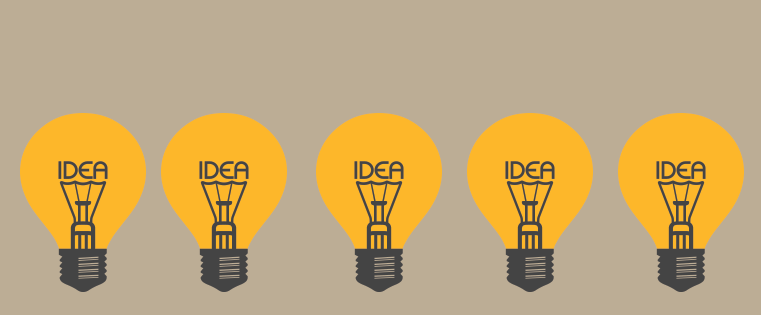
27 Mar Why Your First Idea Might Be Your Worst Idea
[ad_1]

This post originally appeared on HubSpot’s Agency Post. To read more content like this, subscribe to Agency Post.
There’s a common mistake both young professionals and expert contributors fall victim to when coming up with ideas. It’s known as the Einstellung effect — when a person defaults to a known solution rather than a novel or optimal way of solving a problem.
For young creatives, the problem may be that they don’t have the context to know what’s new and what’s a tried-and-true solution.
While in the case of more experienced professionals, the issue is that people tend to rely on historically proven solutions (ones they may have used in the past and know the steps for solving) and become blind to the fact there is a more efficient and effective way to solve a problem. Researchers have studied the Einstellung effect in chess players, finding that when a player recognized the problem, he ignored a more efficient solution in favor of achieving checkmate with a familiar sequence of moves.
The tendency of people to think their first idea is their best idea and to rely on a supply or previour solutions is also known as “design fixation,” and it’s an extremely easy problem for marketers and creatives to fall victim to, resulting in low quality work for clients, a lack of inventiveness, and the stagnation of growth.
To get past your first good idea to the truly great idea, you need to recognize the signs of fixation and put processes in place that encourage “outside the box” thinking and creative advancement.
What Is Design Fixation?
Design fixation, also known as the Einstellung effect, was first studied by Abraham Luchins in 1942 in what is known as the water jar experiment. In the first part of the experiment, participants were asked to transfer water between jars of varying capacity to get to a certain measurement with the restriction that although they could transfer water between the containers, when doing so, they had to fill the container being used to capacity. Jar A held 21 units, Jar B held 127, and Jar C held 3 units. To get to 100 units, you would fill Jar B to 127, and then empty this into Jar A, leaving you with 106 units in Jar B. Then you fill Jar C two times to reduce Jar B by 6 units.
The next test was given to participants from this previous experiment and a control group. The goal was get to 18 units. Jar A held 15 units, Jar B held 39 units, and Jar C held 3 units. The most simple and clearest solution is to fill both Jar A and Jar C. But for people who participated in the first test, they defaulted to emptying Jar B into Jar A and then filling up Jar C twice (similar to how they solved the problem in the first experiment), while most of the control group found the simpler solution.
The first group recognized a pattern for problem solving and relied on this, while the second group considered the best way to achieve the desired result.
Blindness to possible alternatives is literal in this case. A study by Merim Bilalić and Peter McLeod on chess players that used eye-tracking found that even though participants believed they were looking for faster solutions to achieve checkmate, they did not shift their gaze away from the part of the board where the familiar solution would occur. This blindness actually weakened the skills of experts to the level of novices.
The good news is that the more advanced an expert becomes, the less susceptible to the Einstellung effect she is. But this first requires that the expert become aware of design fixation and the negative impact this bias has on creative output.
How to Get Past Your First Idea
Being aware of your inherent bias toward your first idea or a previously known solution will prompt you to reconsider your approach. But you also need a strategy to counteract its effects.
Due to the time and budget constraints placed on agencies by clients and the inclination to rely on previously successful methods to reduce risk and the chance of losing a client relationship, it can be easy to default to what’s work in the past or the most promising of good, not great, ideas from a brainstorm.
In fact, Luchins found in another subsequent experiment that stress imposed by time limits and negative future consequences, such as being graded on the results, further reduced cognitive flexibility.
Agency teams are under near constant pressure to produce highly creative outputs under these conditions.
To prevent stagnant thinking and the effects of Einstellung, try these approaches:
1) Create Opportunities for Exposure to New Ideas
A great idea is not typically the result of some magic, rather it is the synthesis of multiple ideas into one idea, what’s known as combinatorial creativity. Maria Popova, the author behind Brain Pickings, described it as, “Alive and awake to the world, we amass a collection of cross-disciplinary building blocks — knowledge, memories, bits of information, sparks of inspiration, and other existing ideas — that we then combine and recombine, mostly unconsciously, into something ‘new.’”
By introducing your team to new ideas — outside of the world of marketing and advertising — you are creating more of these building blocks, which may one day collide in new ways and result in a truly great idea.
One way to implement this in your company is to offer a program such as tuition reimbusement. With this benefit, people could be encouraged to either advance a skill relevant to their profession or try out something completely new. The Via Agency has a sabbatical program where those who have been with the agency for 10 years are given six-weeks of paid vacation time.
Giving employees the time and resources to find inspiration and challenge their existing ideas is essential for creative output and growth.
2) Don’t Work Alone
In a study by Daniel Frings on if fatigue increased the Einstellung effect, he found those working in teams were less susceptible. While individuals suffering from sleep deprivation took more steps to solve problems, teams were unaffected. Both groups solved the same number of problems, but the quality of the solutions produced by teams was much higher.
Building diverse teams with people of different backgrounds and experiences, cultures, expertise levels, and knowledge can help your agency produce more insightful and new ideas. When people are in groups, they challenge one another to achieve high quality outputs.
3) Review Previous Projects and Decisions
Having a peer review of projects is another way to make sure your team members don’t rely on known solutions. This is also a good opportunity to check for confirmation bias, where people fail to objectively evaluate a solution because they believe they know the answer. Any evidence that doesn’t support the initial answer is avoided or ignored, and evidence to support their theory is supported.
At Phelps agency, individuals are required to submit their work for peer review. Each week at a lunch, a team will present to the entire agency the objective of a project, the intended audience, and drafts of the campaign. This acts as a large critique and brainstorming session. While it’s up to the group to accept or reject the feedback, it forces individuals to ask questions of the project they may not have before, to prepare and defend their choices (spurring self-reflection), and to become more expert in the process.
4) Break Down the Problem
According to Nathan Crilly’s Fixation and Creativity in Concept Development, designers concerned with fixation relied heavily on Morphological charts (also known as concept combination tables) to help them “detach themselves from their initial ideas.” This is a matrix where design parameters — the essential elements of a project or functions of a product — are listed in the left-hand column. To the right of this, the designer outlines various different ways of including that requirement or meeting that specification.
Here’s a simple example:
| Target Audience | Students | Individual Contributors | Manager/Director | VP/SVP | C-Level |
| Tactics | Blogging | Social Media | Paid Advertising | Email Marketing | Webinars |
| Goals | Website Visits | Subscribers | Leads | Customers | Brand Awareness |
| Metrics | PR Hits | Conversion Rate | Lead Quality | Share | Sales Goal % |
| Timeline | < One Month | 2-6 Months | 6-12 Months | 1-2 Years | |
| Budget | Low | Mid-Range | High |
More diverse initial ideas increase the likelihood that you will come up with an innovative solution to a problem. Use tools and methods, such as SCAMPER and the Lateral Thinking approach to inspire new ways of looking at a problem.
5) Test Your Ideas
Another solution Crilly found beneficial for designers in reducing design fixation was in creating a prototype or testing the idea.
One study participant said:
“Typically, in a brainstorm, people fire off the immediate ideas in their head. I can imagine they would be biased by things they have seen recently or whatever, but I think when you actually come to build things, then the physics of the world kicks in, and you can’t really cheat that stuff. You can try your best but it’s something that either will work or won’t.”
Investing in user testing, gathering feedback from focus groups, or A/B experiments will provide you with facts about which is the optimal solution — or the best idea, and it will reveal if your initial assumptions about the solution were correct or incorrect, resulting in more experience and more possible solutions to draw from for future projects.
[ad_2]
Source link
Social Media Agency, Social Media, Digital Marketing, Digital Marketing Agency, Search Engine Marketing, SEO, digital marketing agency dubai, video content marketing, crossfit marketing dubai, video marketing dubai, digital marketing agency abu dhabi, facebook marketing dubai, facebook marketing abu dhabi, digital marketing agencies in dubai, social media agency, content marketing dubai, content strategy dubai, branding dubai


